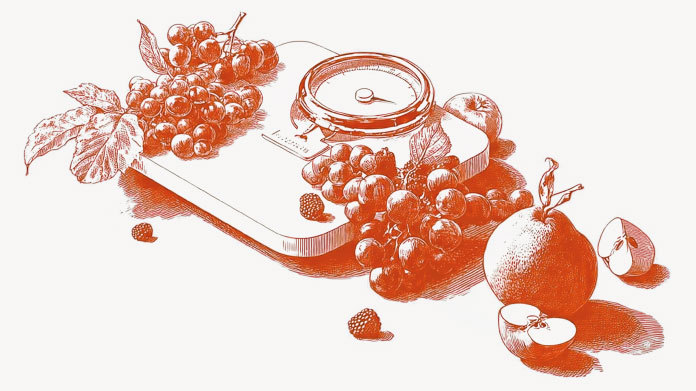10 tips for eating more fiber each day
Fibers? The active role that they play in maintaining proper digestive system function is just one of many roles that fibers play in maintaining overall health. But we’re eating less and less fiber.

Fibers are indigestible polysaccharides (which form carbohydrates) that are found in plants (fruits, vegetables, grains, and legumes). Fibers are essential to our health because they stimulate intestinal transit, boost the immune system, rebalance intestinal flora, lower cholesterol, help us feel sated, and stabilize blood sugar. We can distinguish between two types of fibers: soluble fibers dissolve in water and form a “gel,” while insoluble fibers do not dissolve, but swell, accelerating intestinal transit. Each type of fiber plays different, but complementary roles. Foods rich in fiber contain both soluble and insoluble fibers, but in varying proportions. Fresh fruits, vegetables, and legumes, for example, are richer in soluble fibers, while whole grains have more insoluble fibers.
It’s therefore best to combine both types of fibers (consuming more soluble fiber) to meet our needs for fiber. That, however, isn’t as easy as it sounds, and we’re not consuming enough fiber (about 15 g per person per day, although recommendations specify 25 to 30 g of fiber per day, 10 to 15 g of that amount as soluble fibers). Here are 10 tips for ensuring you get enough fiber.
Eat fruits and vegetables with their skins
Potatoes, pears, zucchini, and cucumbers: whenever you can, eat fruits and vegetables with their skins, which are rich in fiber. Always wash fruits and vegetables thoroughly, or buy organic produce.
Eat fruits and vegetables whole
Fruits and vegetables are by definition fiber-rich foods. But they provide more fiber if you prepare them whole instead of stewed, pureed, or in a soup.
(Re)discover legumes
Lentils, chickpeas, fava beans, and split peas: legumes, are especially rich in fiber, but we too often ignore them, to our detriment. Try to include legumes in your menu at least once a week.
Eat fruits and vegetables at every meal
Eating fruits and vegetables with every meal is essential for meeting our need for fiber. But it’s equally essential for ensuring that we get enough vitamins and minerals. Don’t forget the recommendations of the National Nutrition and Health Program (PNNS in French): 5 fruits and vegetables per day!
Choose whole wheat bread
Forget about white bread, and be sure to buy whole wheat bread, which is rich in insoluble fibers. You can find whole wheat bread at any bakery or prepare it at home.
Prepare cakes with less-refined flour
Refined flour (T55) has little nutritional value as it contains very little fiber. Replace refined flour entirely or partially with semi-whole or whole flour (T150) when you prepare crêpes, cakes, or pies (you can mix several flours).
Snack on dried fruits
Instead reaching for fatty or sugary snacks or other foods without nutritional value, think of dried fruits (apricots, figs, pears, dates) when you feel a little hungry.
Mix nuts into salads or other foods
Nuts (such as almonds) provide fiber. You can grind nuts and add them to cakes or eat them whole with cheese, fruits, and other healthy foods.
Try whole wheat pastas and whole grain rice
Paradoxically, modern supermarkets now offer more and more traditional whole wheat pastas and whole grain rice, which provide healthy amounts of fiber.
Consider rolled oats, wheat germ, or bran
These three items are all rich in fiber and you can use them in almost anything: in salads, yogurt, smoothies, soups, and vegetable stir fries.
Keywords
5 Days
Availability of quality health…
Availability of quality health supplements and it's wide variety is impressive. Ordering is seamless and shipping even during the holidays is well streamlined.
Mohamad Hussein
20 Days
A Product worth waiting for when not…
A Product worth waiting for when not available and then arriving as a surprise!
DOMINIC
21 Days
On time shipping
On time shipping
GEORGE Verne
23 Days
Ordering was easy and the product was…
Ordering was easy and the product was delivered with no problems. Appreciated that I was notified when it would arrive. Thanks!
MascarC
28 Days
Great customer service - responsive …
I ordered from them and my item was unavailable for sometime. I was super happy when they reactivated my order and shipped my item which arrived very quickly. Great customer service.
Ruth Rueter
29 Days
Super fast shipping
Super fast shipping
Donald Borling
33 Days
Reputable companysearch and the number of…
The research and the number of selection of products.
NAKHJAVAN Shervin
46 Days
The Anti Aromatase is a great product
The Anti Aromatase is a great product. You just need to have constant inventory. Recently this product has been out of stock.
GEORGE Verne
47 Days
Great help on chat
Great help on chat. Knowledgeable and friendly.
Jason Argos
51 Days
Customer service was fast and friendly.
Customer service helped to stop the transaction process of the subscription. I appreciated that.
Greenie
51 Days
I order here due to the high quality of…
I order here due to the high quality of the products and the quick delivery of items - thank you
Barbara J
52 Days
SuperSmart's Eye Pressure supplements: highly recommended!
I purchase SuperSmart's Eye Pressure supplements regularly for over 5 years, and gotta say they are truly a wonderful product for my Glaucoma. Highly recommended if you have eye pain from your Glaucoma.
D. Martinez
57 Days
Quick service
Quick service
MONELL
58 Days
Speedy service.
Speedy service.
ROSENTHAL Marvin
61 Days
Clear website- Efficient
Clear website. Excellent search engine and fast delivery!
Mohamad Hussein



